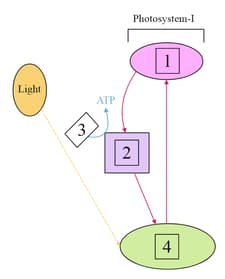Chemiosmosis requires
Important Questions on Photosynthesis in Higher Plants
Which of the following are required for chemiosmosis?
I. A membrane
I. A neutron pump
II. An electron gradient
IV.
The correct answer is:
Assertion A: During photophosphorylation protons are transported across the membrane and accumulated inside the lumen.
Reason R: To develop proton gradient, pheophytin transfers electrons to hydrogen carriers instead of electron carrier.
A) In ATPase enzyme part is embedded in the membrane and forms a transmembrane channel
B) The part of ATPase protrudes on the outer side of the membrane and a proton gradient is formed across the membrane
C) The gradient of the proton provides enough energy to cause a conformational change in particle
D) The change in particle makes the enzyme synthesize ATP
During scheme electrons excited by absorption of light in are transferred to the primary acceptors and therefore must be replaced. The replacements come directly from
Identify the labeled parts as in cyclic photophosphorylation?

Assertion (A): Electrons released from the photosystem are used by the electron transport chain during photophosphorylation.
Reason (R): Movement of electrons from pheophytin to the PS-I reaction centre is an oxidation-reduction reaction.
The correct option among the following is:
Arrange the path of electrons from water to the phycocyanin in the light reaction.
i) Plastoquinone
ii) Excited
iii) Cyt
iv)
v) Pheophytin
vi) Quinone
The correct sequence is
